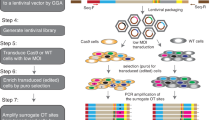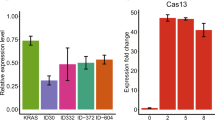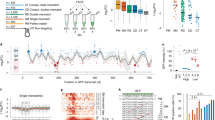Abstract
Off-target gene silencing can present a notable challenge in the interpretation of data from large-scale RNA interference (RNAi) screens. We performed a detailed analysis of off-targeted genes identified by expression profiling of human cells transfected with small interfering RNA (siRNA). Contrary to common assumption, analysis of the subsequent off-target gene database showed that overall identity makes little or no contribution to determining whether the expression of a particular gene will be affected by a given siRNA, except for near-perfect matches. Instead, off-targeting is associated with the presence of one or more perfect 3′ untranslated region (UTR) matches with the hexamer or heptamer seed region (positions 2–7 or 2–8) of the antisense strand of the siRNA. These findings have strong implications for future siRNA design and the application of RNAi in high-throughput screening and therapeutic development.
This is a preview of subscription content, access via your institution
Access options
Subscribe to this journal
Receive 12 print issues and online access
$259.00 per year
only $21.58 per issue
Buy this article
- Purchase on Springer Link
- Instant access to full article PDF
Prices may be subject to local taxes which are calculated during checkout




Similar content being viewed by others
References
Schwarz, D.S. et al. Asymmetry in the assembly of the RNAi enzyme complex. Cell 115, 199–208 (2003).
Reynolds, A. et al. Rational siRNA design for RNA interference. Nat. Biotechnol. 22, 326–330 (2004).
Khvorova, A., Reynolds, A. & Jayasena, S. Functional siRNAs and miRNAs exhibit strand bias. Cell 115, 209–216 (2003).
Naito, Y., Yamada, T., Ui-Tei, K., Morishita, S. & Saigo, K. siDirect: highly effective, target-specific siRNA design software for mammalian RNA interference. Nucleic Acids Res. 32, W124–W129 (2004).
Jagla, B. et al. Sequence characteristics of functional siRNAs. RNA 11, 864–872 (2005).
Huesken, D. et al. Design of a genome-wide siRNA library using an artificial neural network. Nat. Biotechnol. 23, 995–1001 (2005).
Jackson, A.L. et al. Expression profiling reveals off-target gene regulation by RNAi. Nat. Biotechnol. 21, 635–637 (2003).
Lin, X. et al. siRNA-mediated off-target gene silencing triggered by a 7 nt complementation. Nucleic Acids Res. 33, 4527–4535 (2005).
Elbashir, S.M., Harborth, J., Weber, K. & Tuschl, T. Analysis of gene function in somatic mammalian cells using small interfering RNAs. Methods 26, 199–213 (2002).
Amarzguioui, M., Holen, T., Babaie, E. & Prydz, H. Tolerance for mutations and chemical modifications in a siRNA. Nucleic Acids Res. 31, 589–595 (2003).
Holen, T., Amarzguioui, M., Wiiger, M.T., Babaie, E. & Prydz, H. Positional effects of short interfering RNAs targeting the human coagulation trigger tissue factor. Nucleic Acids Res. 30, 1757–1766 (2002).
Altschul, S. et al. Gapped BLAST and PSI-BLAST: a new generation of protein database search programs. Nucleic Acids Res. 25, 3389–3402 (1997).
Smith, T.F. & Waterman, M.S. Identification of common molecular subsequences. J. Mol. Biol. 147, 195–197 (1981).
Lim, L. et al. Microarray analysis shows that some microRNAs downregulate large numbers of target mRNAs. Nature 433, 769–773 (2005).
Scaringe, S.A. Advanced 5′-silyl-2′-orthoester approach to RNA oligonucleotide synthesis. Methods Enzymol. 317, 3–18 (2000).
Acknowledgements
We thank R. Knight for discussion and data analysis advice. We also thank the Dharmacon Production Team for synthesizing the siRNAs used in this work, and J. Kendall and A. O'Brien for providing assistance and direction in manuscript preparation.
Author information
Authors and Affiliations
Corresponding author
Ethics declarations
Competing interests
The authors of this article are employed by Dharmacon or Agilent Technologies, which could potentially benefit from publication of this manuscript.
Supplementary information
Supplementary Fig. 1
Variations of Smith-Waterman scoring parameters fail to improve the ability to distinguish off-targets from untargeted genes. (PDF 38 kb)
Supplementary Fig. 2
Web site tool for identification of potential off-targets based on 3UTR-hexamer seed matches. (PDF 49 kb)
Supplementary Fig. 3
Seed region-off-targeting association is not due to 3′ UTR length. (PDF 16 kb)
Supplementary Table 1
List of siRNA used in study. (PDF 37 kb)
Supplementary Table 2
Table of validated and predicted off-targets. (PDF 15 kb)
Supplementary Table 3
Custom S-W scoring parameters. (PDF 20 kb)
Rights and permissions
About this article
Cite this article
Birmingham, A., Anderson, E., Reynolds, A. et al. 3′ UTR seed matches, but not overall identity, are associated with RNAi off-targets. Nat Methods 3, 199–204 (2006). https://doi.org/10.1038/nmeth854
Received:
Accepted:
Published:
Issue Date:
DOI: https://doi.org/10.1038/nmeth854
This article is cited by
-
Genome-scale pan-cancer interrogation of lncRNA dependencies using CasRx
Nature Methods (2024)
-
RNAi-directed knockdown in the cnidarian fish blood parasite Sphaerospora molnari
Scientific Reports (2024)
-
RNA interference in the era of nucleic acid therapeutics
Nature Biotechnology (2024)
-
Oligonucleotide therapeutics and their chemical modification strategies for clinical applications
Journal of Pharmaceutical Investigation (2024)
-
Precise transcript targeting by CRISPR-Csm complexes
Nature Biotechnology (2023)



